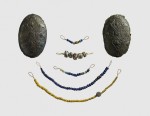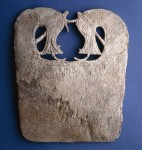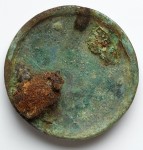 Barry Ager, curator of the British Museum’s Early Medieval Scandinavian and continental Europe collection, has discovered a Celtic brooch dating from the 8th-9th century hidden among Viking burial artifacts found in the late 19th century and kept in the museum’s stores. The objects were excavated in Lilleberge, Norway, in 1886 by British archaeologist Alfred Heneage Cocks. The 9th-10th century burial was a long barrow 128 feet in length containing a 30 foot boat, grave goods and the skeletal remains of a high status woman. The artifacts included beaded necklaces, two oval brooches, a whalebone plaque decorated with horse heads that may have been a food serving tray, an iron grid, possibly used as a pot stand or as a boat fitting, a pottery spindle-whorl, plus iron rivets, nails and wood fragments from the boat.
Barry Ager, curator of the British Museum’s Early Medieval Scandinavian and continental Europe collection, has discovered a Celtic brooch dating from the 8th-9th century hidden among Viking burial artifacts found in the late 19th century and kept in the museum’s stores. The objects were excavated in Lilleberge, Norway, in 1886 by British archaeologist Alfred Heneage Cocks. The 9th-10th century burial was a long barrow 128 feet in length containing a 30 foot boat, grave goods and the skeletal remains of a high status woman. The artifacts included beaded necklaces, two oval brooches, a whalebone plaque decorated with horse heads that may have been a food serving tray, an iron grid, possibly used as a pot stand or as a boat fitting, a pottery spindle-whorl, plus iron rivets, nails and wood fragments from the boat.
 Five years after the excavation, Cocks sold his collection of Lilleberge artifacts to the British Museum. Some of the objects were indeterminate, still encased in blocks of soil and organic matter from the excavation. They were kept in storage for more than a century and only recently been subject to further research. Their uncleaned condition has proven to be an archaeological boon since small organic fragments survived in the dirt and the kind of things that people paid no attention to back then are extremely valuable to researchers today.
Five years after the excavation, Cocks sold his collection of Lilleberge artifacts to the British Museum. Some of the objects were indeterminate, still encased in blocks of soil and organic matter from the excavation. They were kept in storage for more than a century and only recently been subject to further research. Their uncleaned condition has proven to be an archaeological boon since small organic fragments survived in the dirt and the kind of things that people paid no attention to back then are extremely valuable to researchers today.
Barry Ager was looking over the collection in anticipation of a visiting Norwegian expert researching the Lilleberge find when he noticed a piece of metal sticking out of a lump of organic material. He had the lump X-rayed to see what it might contain.
“It turned out, quite remarkably, to be this Celtic disc… It’s extremely exciting… It’s a very rare example of its sort within the collection… shows contact between the British Isles and Norway in the Viking period … objects seized as loot in this country and taken back.”
He believes that it was originally made in Ireland or Scotland, that it came from a shrine or a reliquary, and that the Vikings converted it into a brooch by attaching rivet holes and a pin.
 The brooch couldn’t just be pulled out of the block because there are significant organic survivals — wood fragments, possibly from a box that held the brooch, and very rare Viking textiles from which three different patterns, including a herringbone, have already been identified — that needed to be preserved. Conservators painstakingly removed the brooch using scalpels to separate it from its context without damaging the fragile organics.
The brooch couldn’t just be pulled out of the block because there are significant organic survivals — wood fragments, possibly from a box that held the brooch, and very rare Viking textiles from which three different patterns, including a herringbone, have already been identified — that needed to be preserved. Conservators painstakingly removed the brooch using scalpels to separate it from its context without damaging the fragile organics.
Once it was removed and cleaned, the brooch was found to be elaborately decorated and in excellent condition with its original gilded surface still shining. It’s six centimeters (2.3 inches) in diameter and engraved with a central roundel with three stylized dolphin-like heads looping around it.
“The …patterns, the quatrefoil of the central roundel and the form of the ‘dolphins’ heads have clear parallels in Celtic metalwork and manuscripts of the 8th to early 9th centuries, such as the Tara Brooch and the Book of Mac Regol,” Ager said.
He described the craftsmanship as “very fine” and said that the Vikings valued “eye-catching” objects: “The Vikings themselves were very skilled metalworkers, so I’m sure that’s something that would appeal to a Viking eye.”
The brooch will go on public display for the first time starting March 27th. It will join the exquisite beauties of Sutton Hoo in Room 41 of the British Museum when the gallery re-opens after refurbishment.
Excellent post, fantastic find. If I could start life over again, I would go into museum conservation work. How exciting to get to work with objects like that!
So he believes that viking ruffians took that ‘celtic’ disc from a reliquary in Ireland in order to take it back to Norway and to turn it there into a celtic ‘brooch’ ?
Fair enough, why not ? There might, however, be a parallel to the ‘three hares’ motif, to which a norse approach might be these ‘three salmons’.
I grew up in northwestern maritime part of N. America, and from childhood familiar with salmon and dolphins as well as an artistic tradition that also used them in stylized ways to decorate objects. My immediate response is that those are dolphins, doing what dolphins do. I did not get the sense that Vikings were being referred to as “ruffians”. I am descended from both Vikings and Celts, and am willing to acknowledge that at times both were ruffian like in their behavior. Though I suppose no more so than southern Europeans and others. Times change. FWIW.
:notworthy: I have a Viking piece, belt buckle made of bronze that came from Lake Lagoda. The engravings are Viking and very clear. I can’t find anyone to even guess what it’s worth. It was enclosed in white stone when I got it. Over the time I’ve gotten rid of the white stone. Now it could even be used today-one piece!
I read every word looking for what kind of metal the disc was made from but never found it.